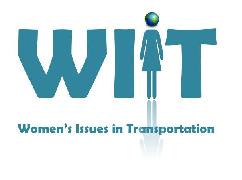 |
5th International Conference on Women's Issues in Transportation - Bridging the Gap
14-16 Apr 2014 Paris - La Défense (France)
|
Themes and topics > Sustainability - Pillar 3Three pillars of sustainability relate to economic, societal, and environmental considerations. Within those three areas is an enormous set of issues. Economic measures relate to factors such as access to opportunities (work, education, engagement, etc.), financial burdens (on individuals, government/taxes, etc.), and the cost of travel (business, insurance, etc.). Societal measures are vast and include health (mental and physical), social capital (community (dis)connections, interaction, etc.), crash costs (emotional, etc.), among others. While environmental aspects might relate to local impacts (e.g. local air contaminants) or global (e.g. climate change). Different transportation modes and systems interact with those issues differently, and how they impact men and women may also differ. Further, those impacts might differ depending on other contextual factors such as the country’s development (e.g. development goals, financial capacity, knowledge capacity, etc.) or cultural aspects that relate to individual vs community rights, conceptualization of quality-of-life (e.g. economic vs subjective well-being, etc.), and so forth. Sustainability, transport, and women’s issues are global concerns, so research from across the globe are sought. We encourage research papers dealing with any aspect of sustainability and critical impacts on women, especially where they would differ from men. However, we also propose some questions:1) Will or are the needs of women being met by sustainable transportation? For example, How might a shift to more sustainable transportation infrastructure affect women (w.r.t to men)? If greater sustainable infrastructure exists that allows greater independent travel for children, might this improve time stress for mothers (although men also take care of children, en aggregate and in reported countries, women accompany children more often)? If women have less access to household wealth, or have lower average independent incomes, how might changes to more sustainable infrastructure affect them? If women’s destinations vary from men’s, the location of more sustainable transportation infrastructure might affect the genders differently. How could sustainable development better consider such differences? 2) Is the conceptualization of sustainable transportation, or how it is being measured influenced by gender biases? For example, Sustainable transportation often focuses on environmental impacts, but changes to transportation affect the economy and society as well. Where are the gains and losses and do they affect the genders differently? Sustainable Transportation Indicators (STIs) exist and their use will affect decision processes. Are they gender-neutral? Examples of STIs: Partnership for Sustainable Urban Transport in Asia Centre for Sustainable Transportation’s Sustainable Transportation Performance Indicators Victoria Transportation Policy Institute: 3) Are policies or practices related to sustainable transportation failing to take women into account? For example, Is the decision-making process of transportation sustainability policies affected by gender bias? Are the transportation evaluation processes valuing one gender over another? Would such decisions negatively affect’s women’s travel or sustainability? Are there gender preferences that affect decision-maker choices (if the decision-makers are not equally balanced between the genders)? 4) If measures of travel/mobility for men and women are converging, is the direction of this convergence desirable from the perspective of sustainability (e.g. are they converging at unsustainable levels of mobility)? For example, If the distances being travelled by women are increasing at a greater rate then men, convergence, and by some definitions, equality may occur. What is the result of that in terms of sustainability? Are people spending more time, energy, and money travelling? Is that improving society or simply increasing mobility for mobility’s sake? 5) Is sustainable infrastructure, or the modes themselves, designed with appropriate consideration to women? For example, Where and in what form cycle lanes are placed may relate to gender preferences. One gender may prefer on-the-road cycle lanes, while another may prefer completely segregated lanes. How might the different placement affect use by the different genders? What potential side-effects (positive or negative) might there be? Are there differences between the sexes for the various sustainable modes? E.g. Preferences to the use of different modes why those preferences exist. Would one mode have greater positive impacts on women’s issues than another? What infrastructure considerations would best improve conditions for women? 6) Urban form can affect what sustainable choices are realistically available and the resultant behavior. How do different development forms influence transport choices across the genders and what effects on sustainability (environmental, social, and economic) do they have? Are different development forms catering to different gender preferences or societal expectations of gender-specific accomplishments? |
| Online user: 1 | RSS Feed |

|
